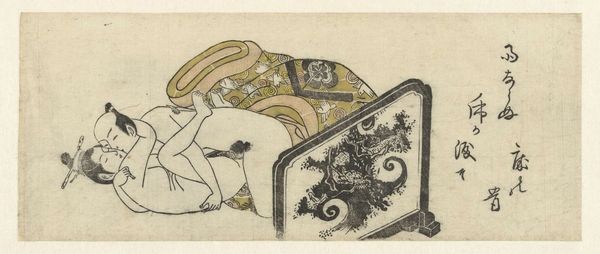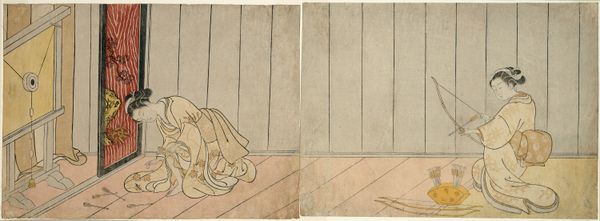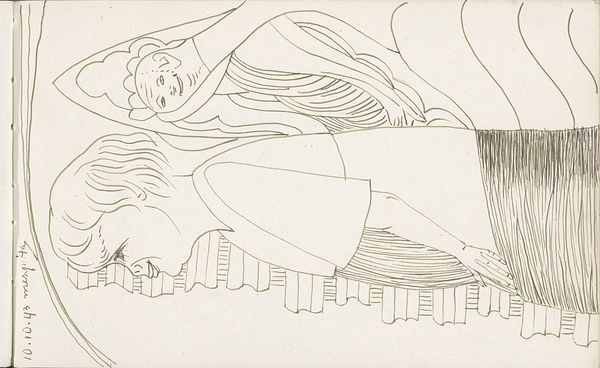
print, woodblock-print
#
portrait
# print
#
asian-art
#
ukiyo-e
#
figuration
#
woodblock-print
#
genre-painting
#
erotic-art
Dimensions: height 128 mm, width 672 mm
Copyright: Rijks Museum: Open Domain
Editor: Here we have Torii Kiyonaga’s "Geisha met gesloten ogen," a woodblock print from 1785 in the Rijksmuseum. The title translates to "Geisha with closed eyes". I'm immediately struck by the arrangement of figures and the delicate, almost dreamlike quality of the image. What elements of its formal composition do you find most compelling? Curator: Indeed, the formal arrangement is paramount. Note the carefully orchestrated rhythm established by the alternating planes of color and texture. The flat, unmodulated fields create a sense of spatial ambiguity. Consider also the elegant, curvilinear outlines. They establish a harmonious dialogue between the figures and the negative space surrounding them, what purpose do you think is established by having a horizontal print style for a portrait piece? Editor: The horizontal orientation seems unusual for a portrait. Is it perhaps suggesting a sense of intimacy or extended narrative, presenting multiple figures in a continuous scene? The flow feels very graceful across the composition as it builds upon itself through multiple characters. Curator: Precisely. And we should not overlook the restricted palette, which operates less in the domain of verisimilitude and more in the realm of symbolic color. The subdued tones enhance the overall feeling of restrained elegance and inner contemplation, creating a particular sensibility. Can you sense it in this piece? Editor: Definitely. It is calm and introspective, perhaps a commentary on the role of women in Edo period society? Is there any semiotic connection? Curator: The "closed eyes" motif immediately invites speculation about the nature of sight and insight, inviting the viewer to consider the geisha’s internal world, inaccessible yet present, what’s also critical to analyze here are the compositional structure and interplay of shapes, rather than simply looking for historical or social readings. Editor: I see now. It’s a delicate balance between surface and depth, line and plane. Thanks! Curator: The exercise lies in identifying the internal mechanics of the composition before seeking any symbolic weight. We appreciate more clearly its art.
Comments
No comments
Be the first to comment and join the conversation on the ultimate creative platform.














